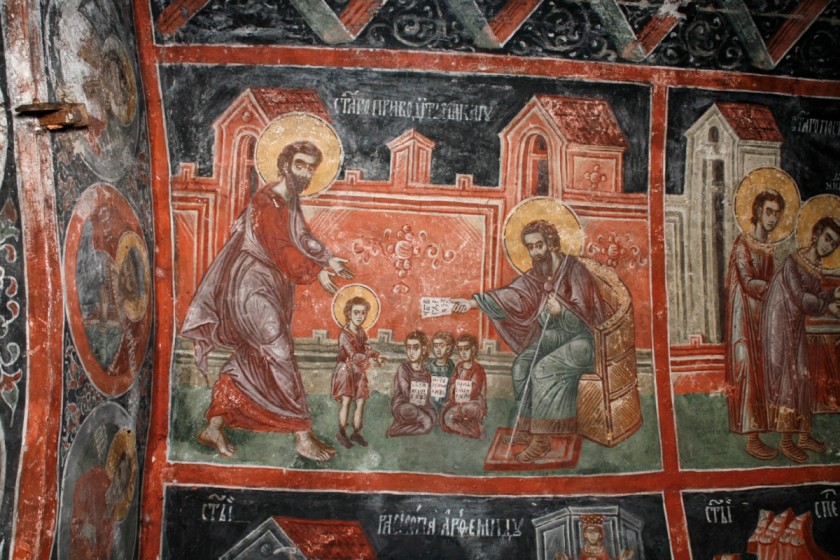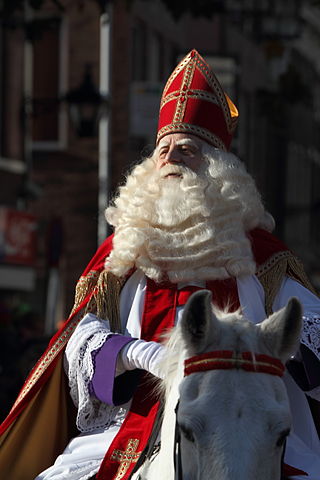The historical life of St. Nicholas is shrouded in legend. Born in modern-day Turkey on March 15, AD270, Nicholas was the only child of rich parents who died in a plague, leaving the boy a wealthy orphan.

Nicholas was raised in the Christian faith and became an early bishop in the Greek church. One of many stories concerning the bishop’s generosity involves a destitute father, unable to raise a dowry sufficient to marry off his three daughters. On two consecutive nights, Nicholas crept up to the man’s window, and dropped a small sack of gold coins. On the third night, the man stayed up to learn the identity of his secret benefactor, only to be asked to keep the name, secret.

Saint Nicholas passed on December 6 in the year 343. He’s entombed in a marble cathedral dedicated to his name, in Myra.

Nicholas is remembered as the patron saint of whole nations and cities such as Amsterdam and Moscow, revered among the early Christian saints and remembered for a legendary habit of secret gift-giving.
Some ideas take hold in the popular imagination, while others fade into obscurity. The “Three Daughters” episode made it into nearly every artistic medium available at that time, from frescoes to carvings and windows, even theatrical performances.
The Patron Saint not only of sailors, but of ships and their cargoes, the seas were the internet of the day, and the story of St. Nick spread from the Balkans to Holland, from England to Crete.
 The Feast of St. Nicholas took hold around the 6th of December. Children and other marginal groups such as old women and slaves could receive gifts, but only by demanding them. The secret giving of gifts appeared sometime around the year 1200.
The Feast of St. Nicholas took hold around the 6th of December. Children and other marginal groups such as old women and slaves could receive gifts, but only by demanding them. The secret giving of gifts appeared sometime around the year 1200.
On the continent, legends of St. Nicholas combined with Pagan traditions and developed in quirky directions, including an evil doppelgänger who accompanies St. Nick on his rounds. As early as the 11th century, the Krampus may be expected to snatch bad little tykes away from parts of Germany, Austria and the Alpine villages of northern Italy, never to be seen again.
In eastern Europe, the witch Frau Perchta “The Disemboweller” was said to place pieces of silver in the shoes of children and servants who’d been good over the year, and replace the organs of the bad ones, with garbage. Yikes.
In French-speaking regions, Père Fouettard (Father Whipper) accompanies Père Noël on gift-giving rounds, dispensing beatings and/or lumps of coal to naughty boys & girls. In some German speaking regions, the malevolent Schmutzli accompanies Samichlaus, with a twig broom to spank wicked children.
Never mind Santa Claus. The Schmutzli is watching.

The “Little Ice Age” of the 13th century, led to a proliferation of chimneys. Windows and doors were the things of thieves and vagabonds, while the chimney led directly to the warm heart of the home. St. Nick made his first gift-giving appearance via the chimney in a three daughters fresco, painted sometime in 1392, in Serbia.

St. Nicholas was beginning to be seen as part of the family outside of the Church, which is probably why he survived what came next. Saints reigned in the Christian world until the 16th century, when the Protestant reformation rejected such “idolatry” as a corruption of Christianity.
Whatever you called him: Sinterklaos, Saint-Nikloi or Zinniklos, St. Nick went away entirely in England and Scotland during the time of Henry VIII, giving way to the spirit of Christmas cheer in the person of one Father Christmas. England would no longer keep the feast of the Saint on December 6. The celebration moved to December 25, to coincide with Christmas.
Protestants adopted as gift bringer the Baby Jesus or Christkindl, later morphing into Kris Kringle.
Puritan arrivals to New England rejected Christmas and everything with it, as “un-Christian”. In 1644, Massachusetts levied a fine of five shillings, on anyone observing the holiday.

Sinterklaas survived the iconoclasm of the Reformation in places like Holland, transferring to the 17th century settlement of New Amsterdam: what we now know as the new world port city of New York.
Sinterklass blended with Father Christmas, to create a distinctly American Santeclaus, which began to take hold in the 19th century.
The Christmas “celebrations” of the period, looked more like Mardi Gras than what we know today. Drunk and rowdy gangs wandered the streets of New York, Philadelphia and the cities of the northeast, something between a noisy mob and a marching band. Men fired guns into the air and banged or blew on anything that would make noise. Mobs would beat up the unfortunate, and break into the homes of the “upper classes”, demanding food and liquor.
New York philanthropist John Pintard, the man responsible for the holidays celebrating the fourth of July and George Washington’s birthday, popularized an image first set forth by Washington Irving, in his satirical story A History of New York from the Beginning of the World to the End of the Dutch Dynasty, by Diedrich Knickerbocker, depicting St. Nicholas bringing gifts to good little boys and girls, and switches with which to tan the hides of bad kids.
 The unknown genius who published and illustrated A Children’s Friend in 1821, first depicted “Santa Claus” not as a Catholic bishop, but as a non-sectarian adult in a fur lined robe, complete with a sleigh inexplicably powered by a single reindeer, coming in through the chimney not on December 6, but on Christmas eve.
The unknown genius who published and illustrated A Children’s Friend in 1821, first depicted “Santa Claus” not as a Catholic bishop, but as a non-sectarian adult in a fur lined robe, complete with a sleigh inexplicably powered by a single reindeer, coming in through the chimney not on December 6, but on Christmas eve.
An anonymous poem believed to have been written on December 24, 1822 and later attributed to Clement Clarke Moore, began with the words: “T’was the night before Christmas, and all through the house“…
“A Visit From St. Nicholas“, better known by its first line, gave us the first description of the modern Santa Claus and a tool for domesticating the occasion, agreeable to law enforcement for calming the rowdy streets, to manufacturers and retailers for selling goods, to the church to make way for a family friendly day of worship and to parents, to control unruly children.

The “Right Jolly old Elf” took his modern form thanks to the pen of illustrator and editorial cartoonist Thomas Nast, creator of the Democratic donkey and the Republican elephant and scourge of the Tammany Hall political machine which had swindled New York city, out of millions.
The idea of a Mrs. Claus seems to come from a poem by Katharine Lee Bates of the Cape Cod Curmudgeon’s own town of Falmouth, Massachusetts.
Today, the author is best known for her 1895 poem “Pikes Peak”, later set to music and widely known as “America the Beautiful”.
Tonight, NASA may be expected to track Santa and his sleigh drawn by eight reindeer, though none are any longer, all that tiny. Santa Claus will appear around the planet. Regional variations include Santa’s arriving on a surfboard in Hawaii. In Australia, he’s pulled by six white kangaroos. In Cajun country, Papa Noël arrives in a pirogue, drawn by eight alligators.

Santa Claus may be the most powerful cultural idea, ever conceived. This year, Christmas sales are expected to exceed one Trillion dollars. Not bad for a 2,000-year old saint, best remembered for gift giving with no expectation of anything in return.
Fun fact: Today, the port city of Bari on the Adriatic coast of Italy is remembered for the WW2-era mustard gas accident, which spawned the discovery of modern chemotherapy drugs. A thousand years earlier, city fathers feared growing Muslim influence over the tomb of Saint Nicholas, and went to retrieve his remains. Find him, they did. Saint Nicholas’ large bones were removed and brought back as holy relics to Bari, where they remain, to this day. Smaller fragments were removed during the 1st Crusade and brought back to Venice, or enshrined in basilica from Moscow to Normandy. According to one local antiquarian, the “Tomb of Saint Nicholas” in Ireland, is probably that of a local priest.
Feature image, top of page: Hat tip GP Cox. I don’t know where you got it, but I Love this image. Merry Christmas and all the best for a healthy and prosperous New Year to you and yours, from Mr. & Mrs. Cape Cod Curmudgeon.



Thanks for hat tip!! All the very best to you. This is a remarkable post!! Thanks.

LikeLiked by 1 person
Thank you buddy, for what you do. I’m glad to have met you, albeit online. Merry Christmas, my friend. May this be the first of many more.
LikeLike
Holy #$%…If a threat of a visit from Krampus doesn’t keep a kid straight nothing would.
LikeLiked by 1 person
They have whole Krampus parades in Austria, around the 6th of the month. You can find the video online. Must scare the snot out of the chiddlers.
LikeLiked by 1 person
“Must scare the snot out of the chiddlers.” Heck it would scare me now…
Thanks I will look those up.
LikeLike
Krampus run 2018, Salzburg https://youtu.be/Yg1KJ4lqYQE
LikeLiked by 1 person
Thank you! I saw one in Germany also…. They take this seriously. My son and I are watching some of the parades.
LikeLiked by 1 person